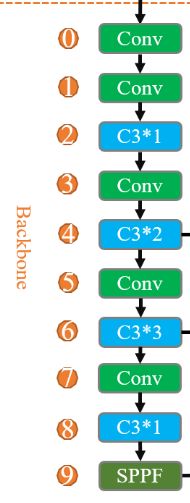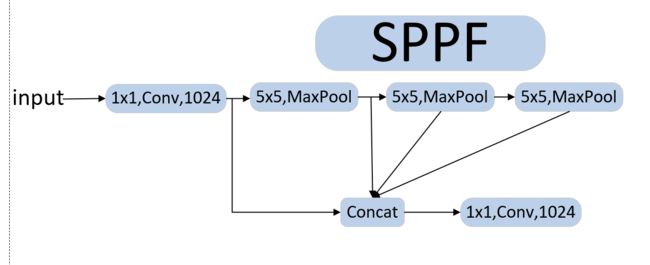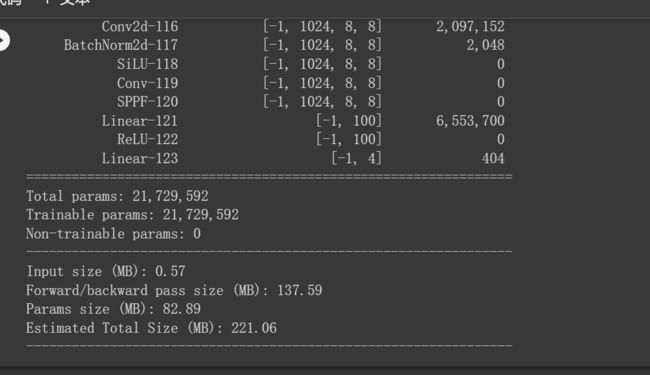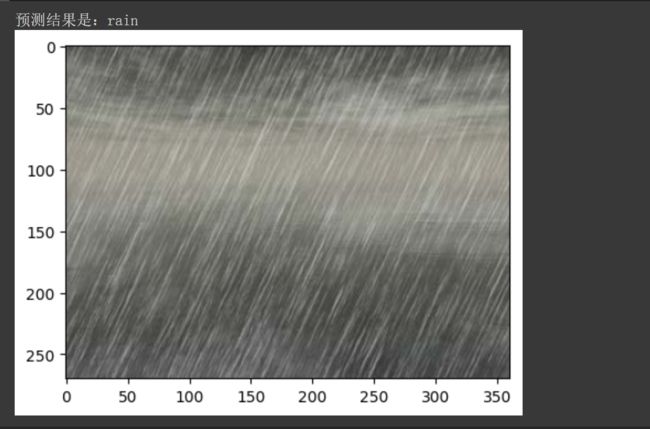YOLOv5-Backbone模块实现-P9
● 本文为365天深度学习训练营 中的学习记录博客
● 参考文章:Pytorch实战 |
第P9周:YOLOv5-Backbone模块实现(训练营内部成员可读)
● 原作者:K同学啊|接辅导、项目定制
我的环境:
● 语言环境:Python 3.8
● 编译器:Pycharm
● 数据集:天气识别数据集
● 深度学习环境:Pytorch
一、 前期准备
1. 设置GPU
如果设备上支持GPU就使用GPU,否则使用CPU
import torch
import torch.nn as nn
import torchvision.transforms as transforms
import torchvision
from torchvision import transforms, datasets
import os,PIL,pathlib,warnings
warnings.filterwarnings("ignore") #忽略警告信息
device = torch.device("cuda" if torch.cuda.is_available() else "cpu")
2. 导入数据
本地数据集位于./data/8-data/目录下
import os,PIL,random,pathlib
data_dir = './data/8-data/'
data_dir = pathlib.Path(data_dir)
data_paths = list(data_dir.glob('*'))
classeNames = [str(path).split("\\")[1] for path in data_paths]
train_transforms = transforms.Compose([
transforms.Resize([224, 224]), # 将输入图片resize成统一尺寸
# transforms.RandomHorizontalFlip(), # 随机水平翻转
transforms.ToTensor(), # 将PIL Image或numpy.ndarray转换为tensor,并归一化到[0,1]之间
transforms.Normalize( # 标准化处理-->转换为标准正太分布(高斯分布),使模型更容易收敛
mean=[0.485, 0.456, 0.406],
std=[0.229, 0.224, 0.225]) # 其中 mean=[0.485,0.456,0.406]与std=[0.229,0.224,0.225] 从数据集中随机抽样计算得到的。
])
total_data = datasets.ImageFolder("/content/weather_photos",transform=train_transforms)
total_data.class_to_idx
3. 划分数据集
train_size = int(0.8 * len(total_data))
test_size = len(total_data) - train_size
train_dataset, test_dataset = torch.utils.data.random_split(total_data, [train_size, test_size])
train_dataset, test_dataset
batch_size = 32
train_dl = torch.utils.data.DataLoader(train_dataset,
batch_size=batch_size,
shuffle=True,
num_workers=1)
test_dl = torch.utils.data.DataLoader(test_dataset,
batch_size=batch_size,
shuffle=True,
num_workers=1)
for X, y in test_dl:
print("Shape of X [N, C, H, W]: ", X.shape)
print("Shape of y: ", y.shape, y.dtype)
break
4. 显示图片信息
#%%
import matplotlib.pyplot as plt
# 指定图片大小,图像大小为20宽、5高的绘图(单位为英寸inch)
plt.figure(figsize=(80, 20))
for i, imgs in enumerate(X[:20]):
# 维度缩减X
npimg = imgs.numpy().transpose((1, 2, 0))
# 将整个figure分成2行10列,绘制第i+1个子图。
plt.subplot(2, 10, i+1)
plt.imshow(npimg, cmap=plt.cm.binary)
plt.axis('off')
二、搭建YOLOv5-Backbone模型
1. 模型
2.代码
import torch.nn.functional as F
def autopad(k, p=None): # kernel, padding
# Pad to 'same'
if p is None:
p = k // 2 if isinstance(k, int) else [x // 2 for x in k] # auto-pad
return p
class Conv(nn.Module):
# Standard convolution
def __init__(self, c1, c2, k=1, s=1, p=None, g=1, act=True): # ch_in, ch_out, kernel, stride, padding, groups
super().__init__()
self.conv = nn.Conv2d(c1, c2, k, s, autopad(k, p), groups=g, bias=False)
self.bn = nn.BatchNorm2d(c2)
self.act = nn.SiLU() if act is True else (act if isinstance(act, nn.Module) else nn.Identity())
def forward(self, x):
return self.act(self.bn(self.conv(x)))
class Bottleneck(nn.Module):
# Standard bottleneck
def __init__(self, c1, c2, shortcut=True, g=1, e=0.5): # ch_in, ch_out, shortcut, groups, expansion
super().__init__()
c_ = int(c2 * e) # hidden channels
self.cv1 = Conv(c1, c_, 1, 1)
self.cv2 = Conv(c_, c2, 3, 1, g=g)
self.add = shortcut and c1 == c2
def forward(self, x):
return x + self.cv2(self.cv1(x)) if self.add else self.cv2(self.cv1(x))
class C3(nn.Module):
# CSP Bottleneck with 3 convolutions
def __init__(self, c1, c2, n=1, shortcut=True, g=1, e=0.5): # ch_in, ch_out, number, shortcut, groups, expansion
super().__init__()
c_ = int(c2 * e) # hidden channels
self.cv1 = Conv(c1, c_, 1, 1)
self.cv2 = Conv(c1, c_, 1, 1)
self.cv3 = Conv(2 * c_, c2, 1) # act=FReLU(c2)
self.m = nn.Sequential(*(Bottleneck(c_, c_, shortcut, g, e=1.0) for _ in range(n)))
#SSPF模块将经过Conv的x、一次池化后的y1、两次池化后的y2和3次池化后的self.m(y2)先进行拼接,然后再Conv提取特征。 仔细观察不难发现,虽然SSPF对特征图进行了多次池化,但是特征图尺寸并未发生变化,通道数更不会变化,所以后续的4个输出能够在channel维度进行融合.
def forward(self, x):
return self.cv3(torch.cat((self.m(self.cv1(x)), self.cv2(x)), dim=1))
class SPPF(nn.Module):
# Spatial Pyramid Pooling - Fast (SPPF) layer for YOLOv5 by Glenn Jocher
def __init__(self, c1, c2, k=5): # equivalent to SPP(k=(5, 9, 13))
super().__init__()
c_ = c1 // 2 # hidden channels
self.cv1 = Conv(c1, c_, 1, 1)
self.cv2 = Conv(c_ * 4, c2, 1, 1)
self.m = nn.MaxPool2d(kernel_size=k, stride=1, padding=k // 2)
def forward(self, x):
x = self.cv1(x)
with warnings.catch_warnings():
warnings.simplefilter('ignore') # suppress torch 1.9.0 max_pool2d() warning
y1 = self.m(x)
y2 = self.m(y1)
return self.cv2(torch.cat([x, y1, y2, self.m(y2)], 1))
"""
这个是YOLOv5, 6.0版本的主干网络,这里进行复现
(注:有部分删改,详细讲解将在后续进行展开)
"""
class YOLOv5_backbone(nn.Module):
def __init__(self):
super(YOLOv5_backbone, self).__init__()
self.Conv_1 = Conv(3, 64, 3, 2, 2)
self.Conv_2 = Conv(64, 128, 3, 2)
self.C3_3 = C3(128,128)
self.Conv_4 = Conv(128, 256, 3, 2)
self.C3_5 = C3(256,256)
self.Conv_6 = Conv(256, 512, 3, 2)
self.C3_7 = C3(512,512)
self.Conv_8 = Conv(512, 1024, 3, 2)
self.C3_9 = C3(1024, 1024)
self.SPPF = SPPF(1024, 1024, 5)
# 全连接网络层,用于分类
self.classifier = nn.Sequential(
nn.Linear(in_features=65536, out_features=100),
nn.ReLU(),
nn.Linear(in_features=100, out_features=4)
)
def forward(self, x):
x = self.Conv_1(x)
x = self.Conv_2(x)
x = self.C3_3(x)
x = self.Conv_4(x)
x = self.C3_5(x)
x = self.Conv_6(x)
x = self.C3_7(x)
x = self.Conv_8(x)
x = self.C3_9(x)
x = self.SPPF(x)
x = torch.flatten(x, start_dim=1)
x = self.classifier(x)
return x
device = "cuda" if torch.cuda.is_available() else "cpu"
print("Using {} device".format(device))
model = YOLOv5_backbone().to(device)
model
#
3. 统计模型参数量以及其他指标
三、训练模型
1. 编写训练和测试函数
见之前文章
2.正式训练
3.指定图片预测
4.模型评估
总结:
本次学习了YOLOv5-Backbone模块.
参考
YOLOv5的Backbone设计








